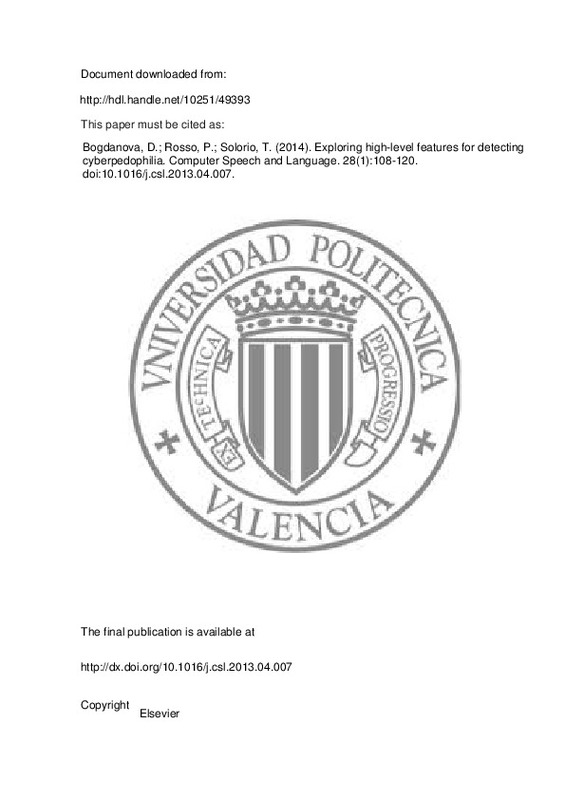JavaScript is disabled for your browser. Some features of this site may not work without it.
Buscar en RiuNet
Listar
Mi cuenta
Estadísticas
Ayuda RiuNet
Admin. UPV
Exploring high-level features for detecting cyberpedophilia
Mostrar el registro sencillo del ítem
Ficheros en el ítem
| dc.contributor.author | Bogdanova, Dasha
|
es_ES |
| dc.contributor.author | Rosso, Paolo
|
es_ES |
| dc.contributor.author | Solorio, Thamar
|
es_ES |
| dc.date.accessioned | 2015-04-28T12:35:18Z | |
| dc.date.available | 2015-04-28T12:35:18Z | |
| dc.date.issued | 2014-01 | |
| dc.identifier.issn | 0885-2308 | |
| dc.identifier.uri | http://hdl.handle.net/10251/49393 | |
| dc.description.abstract | [EN] In this paper, we suggest a list of high-level features and study their applicability in detection of cyberpedophiles. We used a corpus of chats downloaded from http://www.perverted-justice.com and two negative datasets of different nature: cybersex logs available online, and the NPS chat corpus. The classification results show that the NPS data and the pedophiles’ conversations can be accurately discriminated from each other with character n-grams, while in the more complicated case of cybersex logs there is need for high-level features to reach good accuracy levels. In this latter setting our results show that features that model behaviour and emotion significantly outperform the low-level ones, and achieve a 97% accuracy. | es_ES |
| dc.description.sponsorship | The work of Dasha Bogdanova was partially carried out during the internship at the Universitat Politecnica de Valencia (scholarship of the University of St. Petersburg). Her research was partially supported by Google Research Award. The collaboration with Thamar Solorio was possible thanks to her one-month research visit at the Universitat Politecnica de Valencia (program PAID-PAID-02-11 award n. 1932). The research work of Paolo Rosso was done in the framework of the European Commission WIQ-EI Web Information Quality Evaluation Initiative (IRSES Grant No. 269180) project within the FP 7 Marie Curie People, the DIANA-APPLICATIONS - Finding Hidden Knowledge in Texts: Applications (TIN2012-38603-0O2-01) project, and the VLC/CAMPUS Microcluster on Multimodal Interaction in Intelligent Systems. | en_EN |
| dc.language | Inglés | es_ES |
| dc.publisher | Elsevier | es_ES |
| dc.relation.ispartof | Computer Speech and Language | es_ES |
| dc.rights | Reserva de todos los derechos | es_ES |
| dc.subject | Cyberpedophilia | es_ES |
| dc.subject | Sentiment analysis | es_ES |
| dc.subject | Emotion detection | es_ES |
| dc.subject.classification | LENGUAJES Y SISTEMAS INFORMATICOS | es_ES |
| dc.title | Exploring high-level features for detecting cyberpedophilia | es_ES |
| dc.type | Artículo | es_ES |
| dc.identifier.doi | 10.1016/j.csl.2013.04.007 | |
| dc.relation.projectID | info:eu-repo/grantAgreement/EC/FP7/269180/EU/Web Information Quality Evaluation Initiative/ | es_ES |
| dc.relation.projectID | info:eu-repo/grantAgreement/UPV//PAID-02-11-1932/ | es_ES |
| dc.relation.projectID | info:eu-repo/grantAgreement/MINECO//TIN2012-38603-C02-01/ES/DIANA-APPLICATIONS: FINDING HIDDEN KNOWLEDGE IN TEXTS: APPLICATIONS/ | es_ES |
| dc.rights.accessRights | Abierto | es_ES |
| dc.contributor.affiliation | Universitat Politècnica de València. Departamento de Sistemas Informáticos y Computación - Departament de Sistemes Informàtics i Computació | es_ES |
| dc.description.bibliographicCitation | Bogdanova, D.; Rosso, P.; Solorio, T. (2014). Exploring high-level features for detecting cyberpedophilia. Computer Speech and Language. 28(1):108-120. https://doi.org/10.1016/j.csl.2013.04.007 | es_ES |
| dc.description.accrualMethod | S | es_ES |
| dc.relation.publisherversion | http://dx.doi.org/10.1016/j.csl.2013.04.007 | es_ES |
| dc.description.upvformatpinicio | 108 | es_ES |
| dc.description.upvformatpfin | 120 | es_ES |
| dc.type.version | info:eu-repo/semantics/publishedVersion | es_ES |
| dc.description.volume | 28 | es_ES |
| dc.description.issue | 1 | es_ES |
| dc.relation.senia | 285884 | |
| dc.contributor.funder | European Commission | |
| dc.contributor.funder | Universitat Politècnica de València | |
| dc.contributor.funder | Ministerio de Economía y Competitividad |







![[Cerrado]](/themes/UPV/images/candado.png)

